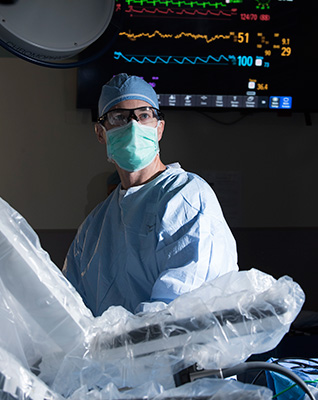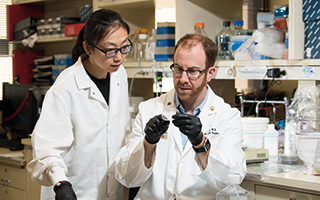Surgeons forge the last laparoscopic frontier

Minimally invasive surgery has become the standard of care for most general surgical procedures. Now Washington University surgeons are leading the effort to introduce these techniques to general surgery’s last laparoscopic frontier: major liver and pancreas surgeries.
“Minimally invasive liver and pancreas surgeries are not very widespread because these are such major operations,” says Chet Hammill, MD, MCR, who joined the faculty in March 2017. “But they’re gaining traction.”
As the former director of hepatobiliary and pancreatic (HPB) surgery for the Legacy Health System in Portland, Ore., Hammill has extensive experience with laparoscopic liver and pancreas surgeries, including distal pancreatectomy, a procedure for treating cancer in which the surgeon removes the tail of the pancreas. He is eager to share his expertise by not only performing these surgeries but also training his fellow HPB-GI surgeons at Barnes-Jewish Hospital to use the same advanced techniques.
“There are good data that show you get the same health outcomes with a minimally invasive distal pancreatectomy as you do performing the open procedure,” says Hammill. “When done laparoscopically, you get the benefits of less pain and blood loss, shorter hospital stay and quicker return to function. These patients typically go home one or two days after surgery compared to four or five days with an open procedure.”
The section’s surgeons are in the early stages of developing a minimally invasive approach for the Whipple procedure, performed to treat pancreas cancer. In this major operation, the surgeon removes the head of the pancreas, gallbladder, part of the stomach, part of the small intestine and the bile duct. For the open procedure, mortality at high-volume centers is 3 percent. But Whipple patients have a 40 percent surgical complication rate, and their rate of survival from the cancer is low.
As a result, improving quality of life for Whipple patients is a high priority for the section’s surgeons. Recently, they implemented a new patient care protocol that emphasizes patient education, an earlier return to activity and normal diet, and improved pain management.
Surgeons perform about 100 Whipple surgeries a year at Barnes-Jewish Hospital.
Highlights

A GENETICALLY ENGINEERED, immunodeficient mouse model under development by Ryan Fields, MD, and a multidisciplinary team could enable cancer specialists to provide more effective care. Researchers inject part of a patient’s tumor and bone marrow into the model, then test how the tumor responds to various therapies. If validated, the model could help cancer specialists choose treatments tailored to each patient. Fields is testing the model in melanoma patients, but it could be applied to all cancers. The research is supported by a National Institutes of Health (NIH) R01 grant; co-investigators include Robert Schreiber, PhD, professor of pathology and immunology, researchers at the Elizabeth H. and James S. McDonnell III Genome Institute at Washington University, and collaborators at Yale University and The Jackson Laboratory.
A SPORE GRANT (Specialized Programs of Research Excellence) received in June 2016 is allowing researchers to take their first steps in developing drugs and immunotherapies to treat pancreatic ductal adenocarcinoma (PDAC). Clinical trials will test a combination of drugs that inhibit the survival pathway of certain cancers, as well as a personalized pancreas cancer vaccine. William Hawkins, MD, HPB-GI surgery section chief, is principal investigator of the $10.4 million grant funded by the National Cancer Institute.
FORMER CHIEF RESIDENT Dominic Sanford, MD, MPHS, who will join the HPB-GI surgery faculty in 2018, coordinated a clinical trial comparing video-based patient instruction before hospital admission and standard instruction during hospital stay in pancreas cancer patients. The trial uses readmission rates and patient-reported outcomes to measure success.